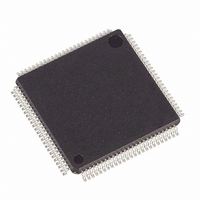DS2152L+ Maxim Integrated Products, DS2152L+ Datasheet - Page 58

DS2152L+
Manufacturer Part Number
DS2152L+
Description
IC TXRX T1 1CHIP ENHNCD 100-LQFP
Manufacturer
Maxim Integrated Products
Datasheet
1.DS2152L.pdf
(97 pages)
Specifications of DS2152L+
Function
Single-Chip Transceiver
Interface
T1
Number Of Circuits
1
Voltage - Supply
4.75 V ~ 5.25 V
Current - Supply
75mA
Operating Temperature
0°C ~ 70°C
Mounting Type
Surface Mount
Package / Case
*
Includes
DSX-1 and CSU Line Build-Out Generator, HDLC Controller, In-Band Loop Code Generator and Detector
Lead Free Status / RoHS Status
Lead free / RoHS Compliant
Power (watts)
-
Like the other status registers in the DS2152, the user will always precede a read of any of the four
registers with a write. The byte written to the register will inform the DS2152 which of the latched bits
the user wishes to read and have cleared (the real-time bits are not affected by writing to the status
register). The user will write a byte to one of these registers, with a 1 in the bit positions he or she wishes
to read and a 0 in the bit positions he or she does not wish to obtain the latest information on. When a 1 is
written to a bit location, the read register will be updated with current value and it will be cleared. When a
0 is written to a bit position, the read register will not be updated and the previous value will be held. A
write to the status and information registers will be immediately followed by a read of the same register.
The read result should be logically ANDed with the mask byte that was just written and this value should
be written back into the same register to insure that bit does indeed clear. This second write step is
necessary because the alarms and events in the status registers occur asynchronously in respect to their
access via the parallel port. This write-read-write (for polled driven access) or write-read (for interrupt-
driven access) scheme allows an external microcontroller or microprocessor to individually poll certain
bits without disturbing the other bits in the register. This operation is key in controlling the DS2152 with
higher-order software languages.
Like the SR1 and SR2 status registers, the FDLS register has the unique ability to initiate a hardware
interrupt via the INT output pin. Each of the events in the FDLS can be either masked or unmasked from
the interrupt pin via the FDL Interrupt Mask Register (FIMR). Interrupts will force the INT pin low when
the event occurs. The INT pin will be allowed to return high (if no other interrupts are present) when the
user reads the event bit that caused the interrupt to occur.
12.1.2 Basic Operation Details
To allow the DS2152 to properly source/receive data from/to the HDLC and BOC controller the legacy
FDL circuitry (which is described in Section 12.2) should be disabled and the following bits should be
programmed as shown:
As a basic guideline for interpreting and sending both HDLC messages and BOC messages, the following
sequences can be applied:
TCR1.2 = 1 (source FDL data from the HDLC and BOC controller)
TBOC.6 = 1 (enable HDLC and BOC controller)
CCR2.5 = 0 (disable SLC-96 and D4 Fs-bit insertion)
CCR2.4 = 0 (disable legacy FDL 0 stuffer)
CCR2.1 = 0 (disable SLC-96 reception)
CCR2.0 = 0 (disable legacy FDL 0 stuffer)
IMR2.4 = 0 (disable legacy receive FDL buffer full interrupt)
IMR2.3 = 0 (disable legacy transmit FDL buffer empty interrupt)
IMR2.2 = 0 (disable legacy FDL match interrupt)
IMR2.1 = 0 (disable legacy FDL abort interrupt)
58 of 97












